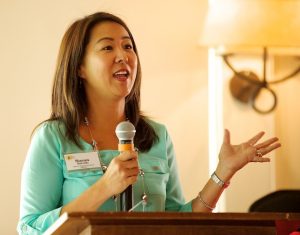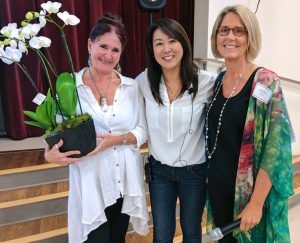
Dr. Salcido graciously agreed to share her thoughts with Jordan Killebrew of the Santa Barbara Foundation about some of the immediate challenges facing our youth, including school safety, a rapidly changing technological world, and how educators can meet the social-emotional needs of an increasingly diverse population of students.
Jordan Killebrew: Why are you passionate about what you do?
Susan Salcido: Santa Barbara County is a place I love. I love those whom we serve, and it is a privilege to live and work in a community that truly believes that all children can be successful when provided equitable opportunities. Education is the key tool for unlocking the door to opportunities. I am passionate about doing all I can to allow every single one of our children those opportunities for success.
We have diverse populations here in Santa Barbara County. My work as county superintendent involves being present in every city and district. There are tremendous differences from area to area — from rural to suburban, from low poverty to high wealth; cultures, languages and experiences are vastly different. The greatest commonality and need is for ALL students, no matter the differences, to receive not merely access, but also equitable instruction, programs, services, opportunities and open doors. The proverbial ceilings should be broken for each and every child. This is what we want for our own children, and it is our children whom we serve throughout Santa Barbara County.
Jordan: What are the top three most pressing issues within youth development in Santa Barbara County?
Susan: Keeping schools safe is of the utmost importance for all of us. But we are in a new era and time—much different from what many of us adults experienced as students. Success in ensuring the safety of our children in our schools will involve partnerships among schools, children, families, community members, law enforcement, and legislators. The approach must be multi-faceted, systematic, and address short-term and long-term factors.
Second, we are preparing our children intellectually and academically for a dynamic, rapidly evolving world that is becoming increasingly complex and complicated. It is imperative that we educators continue to challenge ourselves and stay current on developing technologies so that we can effectively prepare our students for the world that awaits them when they enter the workforce. Beyond academics, we continue to prepare students for skills that are imperative for work environments that require collaboration, prioritization, critical thinking, time management, problem-solving, and more.
And finally, meeting the social and emotional needs of every single child is a priority. It is essential that we continue to develop ways that encourage healthy interactions with technology and social media. The data on technology’s social impacts on youth is irrefutable. Some studies indicate as much as a 50 percent increase in clinical levels of depression amongst our youth, along with higher rates of feeling lonely or left out. Not surprisingly, studies also show these troubling indicators coincide almost perfectly with the increased popularity of smartphones among adolescents. With the proliferation of technology, it is vital we provide young people with the tools to use that technology—and particularly social media—responsibly.
Jordan: What is something that you want people to know about our youth in Santa Barbara County?
Susan: Our students are reaching new heights and blazing new trails in our classrooms and beyond every day. They’re partnering with local businesses and nonprofits to build tiny houses. They offer tax assistance to underserved communities. They develop emerging technologies for application in farming and agricultural practices. They’re creating—from scratch—nonprofit organizations that help combat poverty and food insecurity. They run film festivals and put on dance performances that celebrate their rich cultural heritage. If someone wants assurances about the strength of Santa Barbara County, they need only inquire with their local schools—the true heartbeat of our community.
Jordan: What impact would you say youth development has on our community at large?
Susan: Partnerships in the community are essential for our youth to unlock their full potential. Santa Barbara County is fortunate to have educators, businesses, nonprofit and civic leaders working in partnership with our schools to provide the range of experiences that have such an enormous impact on young lives. An enriching education enables students to make a difference in the world they will inherit, value liberty, and have the courage to pursue what is right and what is good. We believe wholeheartedly in the value of partnerships within our community, and are grateful for the compassionate, and caring community that truly help our youth thrive.
“There are tremendous differences from area to area — from rural to suburban, from low poverty to high wealth; cultures, languages and experiences are vastly different. The greatest commonality and need is for ALL students, no matter the differences, to receive not merely access, but also equitable instruction, programs, services, opportunities and open doors.”
Jordan: What was one of the most rewarding moment or memory from your time with SBCEO, a nonprofit, or within this issue that made you feel like you were really doing good for the community?

Jordan: How can our community do better to address the needs of our youth?
Susan: We must continue to offer individualized support to our students, with a focus on early prevention. In doing so, we support our students, with the goal of giving every one of them an opportunity to succeed.
The importance of addressing the mental health needs of our youth cannot be overstated. One major challenge facing those trying to help is the fact that some consider the subject taboo. But together, we can change the discourse. We can be proactive rather than reactive, helping head off issues before they reach a critical mass. We can focus on awareness. We can listen closely and communicate carefully. While challenges are significant local efforts are helping make a real difference.
Jordan: How do you think SBCEO can better address the needs of our youth?
Susan: We want our office to not just be responsive, but also proactive in education matters on the county, state, and federal levels. We want to continue to educate the community at large on important topics that impact them and their families—from matters of school safety, to preparing the next generation for success in a dynamic world, to helping meet social and emotional needs. If we can help educate and support our community, I am confident it will really help educate and support our students.
Jordan: How do you think the Santa Barbara Foundation can better address the needs of our youth?
Susan: We understand that the call to serve never diminishes. We would love to see a continued expansion of services countywide. In particular, we have a growing population in north Santa Barbara County, including Guadalupe and Santa Maria. We also have important needs in rural New Cuyama. Given the growth in our county, we would love to see a continued expansion of services countywide.